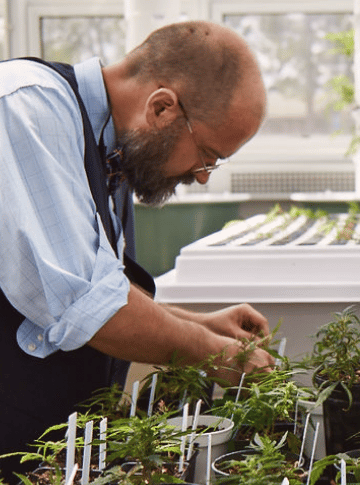Cannabinoids In Plants – A Closer Look
Posted on May 18th, 2023
Here at Tanasi, we’ve built our brand around two cannabinoids in plants: CBD + CBDa. We combine them in a patent-pending, 1:1 formulation that makes CBD 2X more effective. But while most people commonly associate cannabinoids with the cannabis plant, one can also find them in other plant varieties. These compounds are similar to standard cannabinoids, but there are some structural differences. Evaluating cannabinoids in plants can give you a clearer picture of the future of the cannabis industry.
Echinacea
Echinacea, also known as coneflower, is a genus of flowering plants. These plants have a long history of alternative medicinal use for:
- Colds
- Coughs
- Ear infections
- Inflammatory conditions
- Gingivitis
Echinacea is available in many forms. It’s often found in capsules and can also be purchased fresh or in dried form. It’s also common to find echinacea in herbal teas. There’s currently limited research on the effectiveness of echinacea, especially when compared to cannabis. However, it’s still a plant that is worth keeping an eye on.
Black Truffles
Humanity has been cultivating black truffles for several centuries. Black truffles are rich in essential nutrients, like iron and magnesium. While truffles can be part of a meal, black truffle extract is also present in some supplements and skincare products. As researchers look more closely at the benefits these truffles offer, it’s possible that they will become a part of a growing range of products.
Cacao
Cacao, mostly known for being a part of the production of chocolate, contains compounds that can induce feelings of happiness, such as anandamide, phenylethylamine, theobromine, and phenylethylamine, tryptophan. Thus, technically, cacao ranks as what scientists call a ‘superfood.’
The body does naturally produce anandamide. Yet, anandamide derived from plants like cannabis and cacao will remain in the body much longer. It can also provide faster effects.
It’s possible to enjoy the benefits of cacao by merely having a piece of chocolate. With that said, you should be aware that the effects you’ll get from a candy bar will be a lot less potent. Most candy bars contain powdered milk, which can keep your body from properly absorbing the beneficial compounds in cacao. Raw cacao won’t be as sweet, but it will provide more noticeable results.
Kava
When looking into cannabinoids in plants, kava is another plant you’ll want to pay close attention to. This plant, which is native to the South Pacific, has frequent uses in herbal medicine. The plant’s root contains kavalactones, which have sedative properties.
It’s most common to see the roots of the kava plant used to make a beverage. With that said, kava supplements have seen a surge in interest. The natural cannabinoids in kava may not be as potent as the ones you’ll find in cannabis plants, but this plant still has a place in the rotation of natural supplements.
Black Pepper
Black Pepper is a flowering plant that’s best known for the fruit it produces, peppercorn. The fruit is a common spice used all over the world. What many people don’t know about black pepper is that it also has a number of similarities to cannabis plants.
The plant contains a terpene known as beta-caryophyllene. This terpene is what gives many marijuana strains a pepper-like scent. While sprinkling black pepper on your food can be beneficial, the effects will be limited. If you want your body to benefit from the terpenes found in black pepper, you’ll want to look at a supplement derived from this plant. The spice is made exclusively from peppercorns, but the rest of the plant also has potential effects.
Japanese Liverwort
Although the name might lead you to believe that this plant is grown in Asia, it’s actually native to New Zealand. It contains perrottetinene, a cannabinoid that has similarities to THC. Unlike plants with high levels of THC, however, this plant does not have psychoactive properties.
Research on Japanese liverwort is currently limited, but as studies continue, it’s likely that it will be more common to see supplements and other health products derived from the plant. Researchers are currently carrying out controlled clinical studies. They are looking to get a better sense of how the cannabinoids found in the plant affect the body.
Helichrysum
This perennial herb comes primarily from South Africa. It contains cannabigerol, which is a phytocannabinoid that the cannabis plant also contains. There are laws that limit the study of plants grown in South Africa, which means there has been limited research on Helichrysum specifically. However, in recent years, scientists have been able to look at this plant more closely. The plant also has a long history of use as herbal medicine.
Helichrysum contains many cannabis-like compounds, which means it may start to show up in a growing number of supplements in the future. It isn’t as readily available as cannabis, but it does offer some of the same benefits.
Chinese Rhododendron
As the name implies, this flowering plant is native to China. It contains a number of compounds that researchers have described as “synthetic analogs” to cannabinoids. These include cannabicyclol, cannabichromene, and cannabicitran. It also contains anthopogochromenic and anthopogocyclolic acid, which are also similar to cannabinoids.
Reports have found that the plant can be highly effective and that it has minimal side effects. There are currently a number of food products that include Chinese Rhododendron as an ingredient, such as rhododendron honey. You can also find a number of supplements and topical creams that utilize this plant. While its usage varies from cannabis, research backs its effectiveness, and it does offer some of the same benefits.
Acmella Oleracea
This is a species of flowering herb people colloquially refer to as the “toothache plant.” This is because the plant has numbing properties. Currently, there’s very little research on the other benefits the plant offers, but researchers are beginning to look at it more closely.
The plant has a long history of use in traditional medicine, linking it closely to most cannabinoids in plants. Although Acmella oleracea may have fewer benefits than cannabis overall, it’s still a highly potent plant that may become a popular supplement in the future.
Cannabinoids In Plants – The Takeaway
Cannabis has a long list of potential effects. While we only started exploring its effects after the passing of the 2018 farm bill, products made from hemp-derived cannabis are available in many stores across the United States.
Although the effects of cannabis are numerous and popular, it’s worthwhile to look at cannabinoids in plants like kava, Helichrysum, and Japanese liverwort. People who want to keep up with new developments in natural medicine will want to keep a close eye on these plants and products derived from them.





